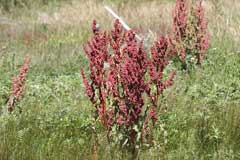 |
|
http://commons.wikimedia.org/wiki/File:Rumex_aquaticus_Sturm56.jpg |
 |
| http://commons.wikimedia.org/wiki/User:Wsiegmund |
Translate this page:
Summary
Physical Characteristics

 Rumex_aquaticus is a PERENNIAL growing to 1.8 m (6ft). It is in flower from July to August. The species is hermaphrodite (has both male and female organs) and is pollinated by Wind.
Rumex_aquaticus is a PERENNIAL growing to 1.8 m (6ft). It is in flower from July to August. The species is hermaphrodite (has both male and female organs) and is pollinated by Wind.
Suitable for: light (sandy), medium (loamy) and heavy (clay) soils. Suitable pH: mildly acid, neutral and basic (mildly alkaline) soils. It can grow in semi-shade (light woodland) or no shade. It prefers wet soil and can grow in water.
UK Hardiness Map
US Hardiness Map
Synonyms
Plant Habitats
Edible Uses
References More on Edible Uses
Medicinal Uses
Plants For A Future can not take any responsibility for any adverse effects from the use of plants. Always seek advice from a professional before using a plant medicinally.
The root is alterative, astringent, cholagogue, deobstruent, depurative, detergent, laxative and mildly tonic[238]. It can cause or relieve diarrhoea according to the dose, harvest time and relative concentrations of tannin(astringent) and anthraquinones (laxative) that are present[222]. It is used internally in the treatment of piles, bleeding of the lungs, various blood complaints and also chronic skin diseases[4, 238]. Externally, it is applied to various skin diseases, ulcers etc[4]. The root has been used with positive effect to restrain the inroads made by cancer, being used as an alterative and tonic[4]. The root is harvested in early spring and dried for later use[4]. Some caution is advised in its use since excess doses can cause gastric disturbance, nausea and dermatitis[222, 238].
References More on Medicinal Uses
The Bookshop: Edible Plant Books
Our Latest books on Perennial Plants For Food Forests and Permaculture Gardens in paperback or digital formats.

Edible Tropical Plants
Food Forest Plants for Hotter Conditions: 250+ Plants For Tropical Food Forests & Permaculture Gardens.
More

Edible Temperate Plants
Plants for Your Food Forest: 500 Plants for Temperate Food Forests & Permaculture Gardens.
More

More Books
PFAF have eight books available in paperback and digital formats. Browse the shop for more information.
Shop Now
Other Uses
Dark green to brown and dark grey dyes can be obtained from the roots of many species in this genus, They do not need a mordant[168]. The dried and powdered root has a cleansing and detergent affect on the teeth[4].
Special Uses
References More on Other Uses
Cultivation details
A plant of shallow water[17].
References Carbon Farming Information and Carbon Sequestration Information
Temperature Converter
Type a value in the Celsius field to convert the value to Fahrenheit:
Fahrenheit:
The PFAF Bookshop
Plants For A Future have a number of books available in paperback and digital form. Book titles include Edible Plants, Edible Perennials, Edible Trees,Edible Shrubs, Woodland Gardening, and Temperate Food Forest Plants. Our new book is Food Forest Plants For Hotter Conditions (Tropical and Sub-Tropical).
Shop Now
Plant Propagation
Seed - sow spring or autumn in situ. Division in spring.
Other Names
If available other names are mentioned here
Native Range
TEMPERATE ASIA: Russian Federation-Ciscaucasia (Ciscaucasia), Russian Federation (Buryatia, Gorno-Altay, Tyva, Respublika, Yakutia-Sakha, Krasnoyarsk, Chelyabinsk, Chita, Aga Buryat, Irkutsk, Novosibirsk, Omsk), Kazakhstan, Kyrgyzstan, Mongolia, Russian Federation (Amur, Cukotskij avtonomnyj okrug, Habarovskij kraj, Kamcatskij kraj, Magadanskaja oblast, Primorye), China (Gansu Sheng, Heilongjiang Sheng, Hubei Sheng, Jilin Sheng, Ningxia Huizi Zizhiqu, Qinghai Sheng, Shaanxi Sheng, Shanxi Sheng, Sichuan Sheng (northwest), Xinjiang Uygur Zizhiqu), Japan EUROPE: Denmark, Finland, United Kingdom (north), Norway, Sweden, Austria, Switzerland, Czech Republic, Germany, Hungary, Poland, Slovakia, Belarus, Estonia, Lithuania, Latvia, Ukraine, Bulgaria, Croatia, Italy (northeast), Montenegro, Romania, Serbia, Slovenia, France
Weed Potential
Right plant wrong place. We are currently updating this section.
Please note that a plant may be invasive in one area but may not in your area so it’s worth checking.
Conservation Status
IUCN Red List of Threatened Plants Status :

Growth: S = slow M = medium F = fast. Soil: L = light (sandy) M = medium H = heavy (clay). pH: A = acid N = neutral B = basic (alkaline). Shade: F = full shade S = semi-shade N = no shade. Moisture: D = dry M = Moist We = wet Wa = water.
Expert comment
Author
L.
Botanical References
17
Links / References
For a list of references used on this page please go here
Readers comment
| Add a comment |
|
If you have important information about this plant that may help other users please add a comment or link below. Only comments or links that are felt to be directly relevant to a plant will be included. If you think a comment/link or information contained on this page is inaccurate or misleading we would welcome your feedback at [email protected]. If you have questions about a plant please use the Forum on this website as we do not have the resources to answer questions ourselves.
* Please note: the comments by website users are not necessarily those held by PFAF and may give misleading or inaccurate information.
To leave a comment please Register or login here All comments need to be approved so will not appear immediately.
|
Subject : Rumex_aquaticus
|
|
|
|